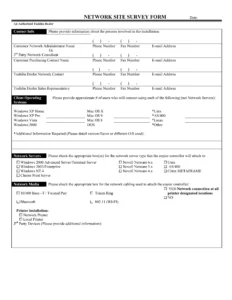Embarking on any new network installation or an upgrade to an existing cabling infrastructure can feel like a daunting task, can’t it? There are so many variables to consider, from the type of cables needed to where they will run, how many users will be supported, and what existing equipment needs to integrate. Without a clear understanding of the environment, you might find yourself facing unexpected challenges and costs down the line. It’s about more than just pulling wires; it’s about creating a robust, reliable foundation for your digital operations.
This is precisely where a well-structured network cable and wiring site survey template becomes an absolute lifesaver. Think of it as your essential roadmap, a detailed checklist that guides you through every critical aspect of your project site. It ensures that no detail, no matter how small, is overlooked, providing you with a comprehensive understanding before any actual work begins. This proactive approach saves time, money, and a lot of headaches, guaranteeing a smoother deployment and a network that truly meets your specific needs.
The Core Elements of a Comprehensive Site Survey
A thorough site survey isn’t merely a walk-through of the premises; it’s a meticulous investigation into every nook and cranny that could impact your network infrastructure. This foundational step is arguably the most crucial phase of any successful cabling project, laying the groundwork for accurate budgeting, efficient planning, and seamless execution. Without this deep dive, you risk miscalculating material needs, encountering unforeseen architectural obstacles, or discovering power deficiencies too late in the game. It truly determines the project’s entire scope and feasibility.
Before even stepping foot on site, a good survey begins with understanding the project’s objectives. Are you installing a completely new network from scratch, upgrading an existing one to support higher speeds, or simply adding a few more drops? Knowing the "why" behind the project helps shape the "what" to look for during the survey. This initial consultation with stakeholders helps identify critical requirements, user density, application needs, and any compliance standards that must be met. It’s also an excellent opportunity to gather existing floor plans or network diagrams, which provide a valuable starting point for your on-site assessment.
Once on location, the real detective work begins. You’re not just looking for space; you’re assessing the environment for suitability, potential interferences, and accessibility. This includes everything from temperature and humidity levels, which can affect equipment longevity, to potential sources of electromagnetic interference from heavy machinery or power lines. Understanding the building’s construction materials is also vital, as they dictate cabling methods and pathways. A robust network cable and wiring site survey template guides you through capturing all of these diverse environmental factors methodically.
Key Areas to Document
To ensure nothing is missed, your survey should systematically cover several critical domains. Each point contributes to a holistic understanding of the site’s readiness and specific requirements.
- Existing Infrastructure Assessment: Document all current network racks, patch panels, active equipment (switches, routers, firewalls), and existing cabling types. Note their condition, age, and capacity.
- Cable Pathways and Routing: Identify potential routes for new cabling, including conduits, cable trays, raceways, drop ceilings, raised floors, and wall cavities. Assess their capacity and any obstructions.
- Power and Grounding: Verify the availability of sufficient power outlets in required locations, examine the condition of existing electrical circuits, and determine if dedicated circuits or UPS systems are necessary. Proper grounding is also paramount for safety and performance.
- Environmental Conditions: Measure ambient temperature and humidity. Look for sources of dust, vibration, and any potential water hazards. Note HVAC capabilities in server rooms or communication closets.
- Safety and Compliance: Identify emergency exits, fire suppression systems, and any hazardous materials or restricted access areas. Ensure compliance with local building codes, fire regulations, and industry standards.
- Security Considerations: Pinpoint locations for security cameras, access control points, and secure server room access. Note any requirements for tamper-proof cabling or locked enclosures.
- Future Expansion Potential: Consider the client’s growth projections. Can the proposed infrastructure easily accommodate additional users, devices, or technology upgrades in the coming years without extensive rework?
Beyond the Wires What a Template Helps You Achieve
While documenting the physical aspects of cable runs and equipment locations is undoubtedly crucial, a comprehensive network cable and wiring site survey template extends its utility far beyond simply mapping out where the wires will go. It transforms a potentially disjointed collection of observations into a cohesive, actionable plan. This structured approach helps bridge the gap between initial client discussions and the final network deployment, ensuring that the theoretical design seamlessly integrates with the practical realities of the physical space. It’s about creating a single source of truth that all project stakeholders can rely on.
One of the most significant benefits of using a standardized template is the consistency it brings to your data collection. Whether you’re surveying a single office building or multiple sites across different locations, the template ensures that the same critical information is gathered every time. This uniformity is invaluable for comparative analysis, standardizing equipment procurement, and maintaining a high level of quality control across all projects. It minimizes the risk of human error or oversight, which can lead to costly reworks or project delays down the line.
Furthermore, a well-executed site survey, guided by a robust template, significantly enhances communication among all parties involved. The detailed documentation becomes a common language, allowing technical teams, project managers, and clients to share a clear and unambiguous understanding of the existing conditions and proposed solutions. This transparency helps manage expectations, clarifies responsibilities, and reduces misunderstandings that often plague complex projects. It ensures everyone is on the same page, from the initial proposal to the final sign-off.
Ultimately, the information meticulously gathered through a network cable and wiring site survey template is the bedrock for accurate project estimation and successful execution. It informs everything from the precise quantity and type of cabling needed to the number of patch panels, conduit requirements, and even the labor hours for installation. This level of detail empowers you to generate more precise quotes, avoid unexpected material shortages, and allocate your resources more efficiently. By identifying potential issues early, you can proactively devise solutions, mitigating risks and ensuring that the project stays on schedule and within budget.
Investing time in a thorough site survey, guided by a specialized template, is not just a preliminary step; it’s a strategic move that pays dividends throughout the entire project lifecycle. It transforms what could be a chaotic undertaking into a streamlined, predictable process, significantly increasing your chances of delivering a high-quality, reliable network infrastructure that perfectly serves its purpose. This foresight ensures that your network not only meets current demands but is also resilient and adaptable for future technological advancements, standing as a testament to meticulous planning and execution.


